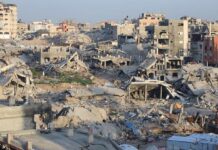Rising acute food insecurity in Somalia has caused more than 900,000 people to flee their homes in search of humanitarian assistance since January last year, the Food and Agriculture Organization (FAO) has warned.
Due to drought and lack of livelihood support, people living in eight areas of the country could be experiencing famine by September. “We cannot wait for famine to be declared; we must act now to safeguard livelihoods and lives,” Rein Paulsen, Director of the FAO Office of Emergencies and Resilience said, following a recent visit to the country.
More than three million animals essential to Somalia’s pastoral communities have died so far and crop production has substantially dropped due to unprecedented poor rainfalls and intense dry conditions.
The continuing death of livestock, key commodity prices rising further and humanitarian assistance failing to reach the most vulnerable, have forced many people living mostly in rural areas, to move to displaced persons camps.
Urgent funding problems
In order to assist 882,000 people across 55 districts with immediate lifesaving and livelihood support, FAO Somalia urgently requires $131.4 million. But famine prevention efforts in Somalia are only 46 per cent funded, and the 2022 Somalia Humanitarian Response Plan is just 43 per cent funded, as of 4 August.
The latter is part of the FAO’s wider Horn of Africa Drought Response Plan, which also covers Kenya, Ethiopia and Djibouti. “We have urgent problems with funding,” Mr Paulsen said.
FAO has been “ringing the alarm bells” since April last year and the failure of successive rains, but a response “hasn’t happened at the levels needed”. This has led to vulnerable farmers being “forced to move as livestock are dying and crops failing. Now everyone has to mobilize quickly and at scale” he added.
Impact of drought
“We are deeply concerned about the drought situation and how vulnerable households are being affected,” Mr Paulsen said, describing how one family of seven travelled over 100 kilometres to reach the displaced persons camp seven months ago.
“They came here because their livestock had died. They came here because they had no means to survive in the rural areas,” he explained.
Agricultural intervention
Agriculture accounts for up to 60 per cent of Somalia’s gross domestic product, 80 per cent of its employment, and 90 per cent of its exports.
Mr Paulsen underlined how it was vitally important to understand that agriculture is a frontline humanitarian response. “Not only does it meet needs, but it also reduces the drivers of those needs effectively. Agriculture needs more attention and more funding to enable timely action in response to agricultural seasons,” he said.
Scale up response
According to Mr. Paulsen, the response in rural areas must be scaled up to help vulnerable people “where they are” as this is “more effective [and] more humane”.
He called for “multi-sectoral responses” to support livelihoods but warned that “more funding from donors,” needed to come in. The focus is on supporting livelihoods, Mr Paulsen explained.
This involves providing cash to allow people to buy food and keep their animals alive with emergency feeding, vet treatments, and water supplies. Farmers must be able to plant, particularly in riverine areas where cropping with irrigation is feasible.













 English
English French
French Spanish
Spanish German
German Dutch
Dutch Italian
Italian Danish
Danish Portuguese
Portuguese Greek
Greek Russian
Russian Swedish
Swedish Bulgarian
Bulgarian Hungarian
Hungarian Catalan
Catalan Ukrainian
Ukrainian Polish
Polish Basque
Basque Chinese (Simplified)
Chinese (Simplified) Japanese
Japanese Hebrew
Hebrew Arabic
Arabic Swahili
Swahili Amharic
Amharic Irish
Irish Afrikaans
Afrikaans Albanian
Albanian Armenian
Armenian Azerbaijani
Azerbaijani Belarusian
Belarusian Bengali
Bengali Bosnian
Bosnian Cebuano
Cebuano Chichewa
Chichewa Chinese (Traditional)
Chinese (Traditional) Corsican
Corsican Croatian
Croatian Czech
Czech Esperanto
Esperanto Estonian
Estonian Filipino
Filipino Finnish
Finnish Frisian
Frisian Galician
Galician Georgian
Georgian Gujarati
Gujarati Haitian Creole
Haitian Creole Hausa
Hausa Hawaiian
Hawaiian Hindi
Hindi Hmong
Hmong Icelandic
Icelandic Igbo
Igbo Indonesian
Indonesian Javanese
Javanese Kannada
Kannada Kazakh
Kazakh Khmer
Khmer Korean
Korean Kurdish (Kurmanji)
Kurdish (Kurmanji) Kyrgyz
Kyrgyz Lao
Lao Latin
Latin Latvian
Latvian Lithuanian
Lithuanian Luxembourgish
Luxembourgish Macedonian
Macedonian Malagasy
Malagasy Malay
Malay Malayalam
Malayalam Maltese
Maltese Maori
Maori Marathi
Marathi Mongolian
Mongolian Myanmar (Burmese)
Myanmar (Burmese) Nepali
Nepali Norwegian
Norwegian Pashto
Pashto Persian
Persian Punjabi
Punjabi Romanian
Romanian Samoan
Samoan Scottish Gaelic
Scottish Gaelic Serbian
Serbian Sesotho
Sesotho Shona
Shona Sindhi
Sindhi Sinhala
Sinhala Slovak
Slovak Slovenian
Slovenian Somali
Somali Sundanese
Sundanese Tajik
Tajik Tamil
Tamil Telugu
Telugu Thai
Thai Turkish
Turkish Urdu
Urdu Uzbek
Uzbek Vietnamese
Vietnamese Welsh
Welsh Xhosa
Xhosa Yiddish
Yiddish Yoruba
Yoruba Zulu
Zulu